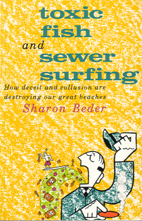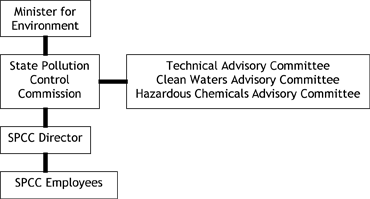
by Sharon Beder
first published by Allen & Unwin, Sydney, 1989
Introduction
Sewers seaward
Toothless watchdog
Toxic fish
Sewer-side surfing
Public relations battle
Events of 1989
Beyond Sydney
Conclusion
Bibliography
The Clean Waters Act forced a few industries to install rudimentary pretreatment equipment where it was not too expensive for them, but little would have been achieved had it not been for the massive diversion of industrial wastes from Sydney's rivers to its sewerage system. Paul Landa, when Minister for Planning and Environment, boasted in a letter to an inquirer that trade wastes from over 6000 factories had been connected to the sewerage system from the commencement of the Clean Waters Act in 1972 to the end of 1978.
In fact the efforts to clean up the environment in the 1970s directed more waste into the sewers because of the emphasis on waste removal, transfer and treatment rather than on pollution prevention and control. Not only was liquid industrial waste diverted to the sewers but air-borne wastes were con- verted to liquid form for disposal to sewer. For example, in the newspaper industry, vapours are drawn off the printing machines and condensed into a liquid which goes down the sewers after minimal treatment. At a 1978 conference, a Sydney Water Board engineer explained that the Board had accepted ‘progressively heavier industrial wastes’ into its system to assist the government in coping with the requirements of the Clean Waters Act.
The rivers and the air were therefore cleaned up at the expense of the ocean and bathing beaches. Rather than increase licence conditions and get individual firms to install more effective pollution control measures, the SPCC has taken the easy way out and diverted the pollution to other areas of the environment that are assumed to be less sensitive. The dependence on the Water Board in achieving the primary goals of the Clean Waters Act is clearly recognised by the SPCC: ‘the existence of a well planned major sewerage system which discharges via ocean outfalls and serves the industrial areas of the basin, and the cooperation of the Metropolitan Water Sewerage and Drainage Board in accepting increased loads of industrial wastes, has made the implementation of point source control effective from the outset’ (Clean Waters Advisory Committee, 9/3/78).
This obviously gave the Board a measure of power in its dealings with the SPCC and has made it very difficult for the SPCC to regulate the Board’s discharge since then. The 1icences for the Water Board’s main ocean outfalls show how difficult it is for the SPCC to regulate the Water Board. They specify existing treating processes rather than effluent quality. For example, until May 1989 the Malabar licence stated that the Water Board could discharge up to 650 ML/day (equivalent to 16,000 average backyard swimming pools) in dry weather conditions and that this flow ‘shall receive screening, degritting and primary treatment’. There were limits on grease and oil, but none on toxic waste, bacterial or viral concentrations set down in these licences. At the time of writing, limits had been set for some toxic substances but neither the SPCC nor the Water Board knew whether they were being met (Steering Committee Meeting, 15/6/89).
For the North Head sewage treatment plant, where primary treatment is not carried out, the licence conditions were relaxed accordingly. They specified only that the flow receive screening, degritting and scum removal. There were no limits on grease or non-filterable residue levels. The licence conditions for Bondi were very similar to those at Malabar except that less grease and oi1 were allowed, presumably because there are less grease and oil in the effluent to start with. The Board also has two other sewage treatment plants discharging into the ocean of Sydney's coastline. At Cronulla the licence conditions do not allow sludge to be dumped and at Warriewood, where secondary treatment is used, the licence conditions specify secondary treatment. It is obvious that 1icence conditions reflect the existing levels of technology installed by the Sydney Water Board rather than water quality objectives. The SPCC is able to do this because the ocean waters were never classified.
The weakness of the SPCC is also explained by the composition of its membership and the membership of the Clean Waters Advisory Committee (see below). They are almost all from government and industry. It was pointed out in parliamentary de- bates when the legislation went through that the groups represented had a vested interest in pollution. Regardless of how dedicated individual representatives of various government departments might be, as public servants they were bound by the terms of their employment and by ministerial directions.
Government appointees were also chosen to reinforce the inherent bias of the Commission. The first Commission had a director, Mr Eric Coffey, who had previously been a Director of Caltex Oil Company and Manager of AOR oi1 refinery. The Commissioner who had been appointed to represent conservation (disowned by the conservation movement) was Mr F. S. Buckley, New South Wales Manager of IC1 and Director of other chemical and plastics manufacturing firms. He was reported as saying that blaming industry or environmental pollution was ‘an emotional fallacy’.
Function: to ensure that all practical measures are taken under the State Pollution Control Commission Act or my other Act (including the Clean Waters Act 1970) to prevent, control or reduce pollution, to control waste disposal and to protect the environment.

State Pollution Control Commission Membership
Government Appointees
Government Representatives: |
The Clean Waters Advisory Committee Membership
Government Appointees
Government Representatives: |
Right from the start there were no penalties for non-compliance with SPCC directives. It was envisaged that disputes would be settled by the Premier and enforced at ministerial or Cabinet level. The SPCC was also forced to compete with the newly formed Department of Environment, which limited its funding and staff. In 1973 the Herald suggested that either the SPCC was regarded as a failure or that it was a threat to Cabinet because of its powers to direct other departments to take action on pollution. The Herald argued that the Government had tried to satisfy two completely opposite political lobbies-big business and the environmentalists—and had instituted the structure for environmental reforms to please the conservationists but had not actively utilised that structure for fear of displeasing industry: ‘in an attempt to appear to reconcile the irreconcilable, the Government erected a facade of environment legislation which, in reality, was a portfolio without power’ (Herald, 25/10/73).
Limited powers and lack of staff have continued to dog the SPCC. In 1987 it had only five inspectors in the whole of Sydney to make sure that no one was discharging without a licence and that those with licences were honouring them. The SPCC is increasingly forced to deal with this problem by getting polluters to monitor themselves. ln their 1988 Annual Report the SPCC outlined a new system aimed at shifting the prime responsibility for monitoring from the Commission to the polluters themselves.